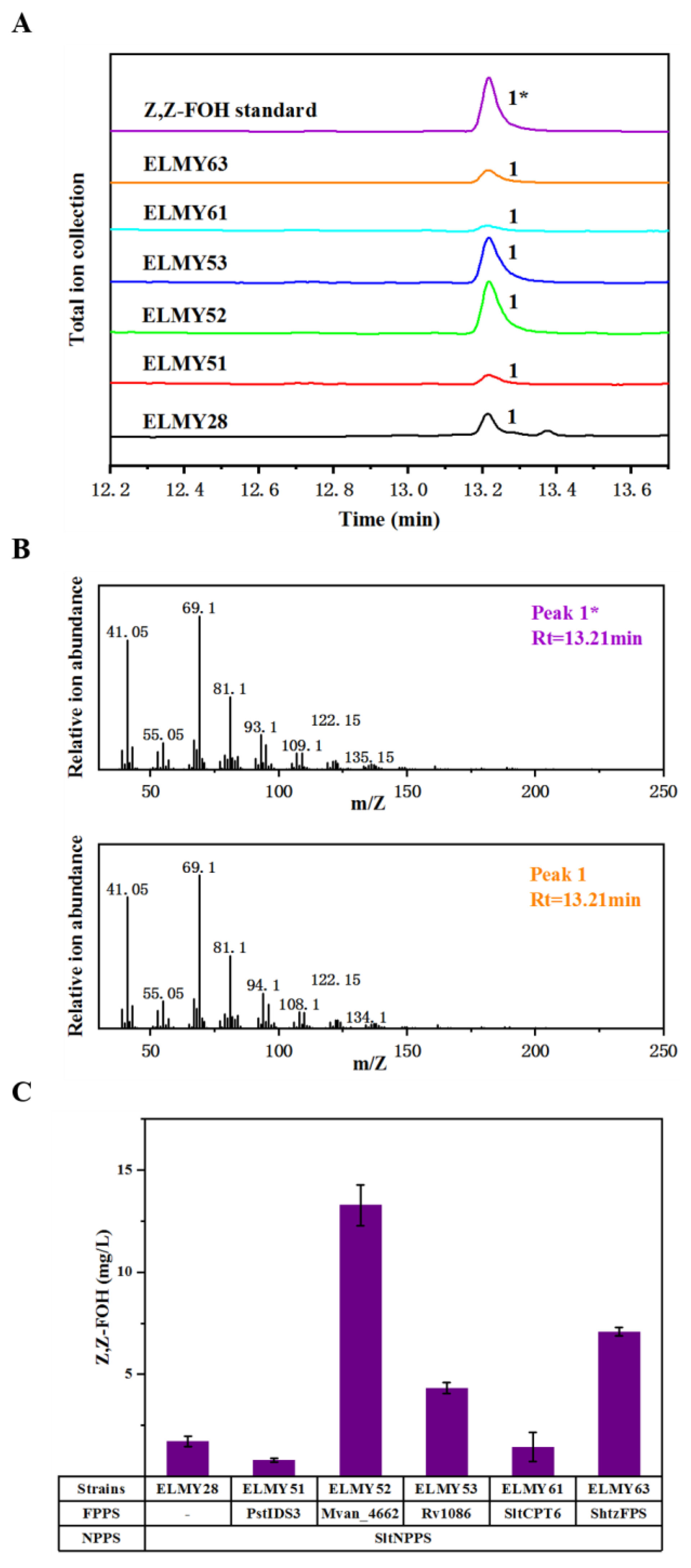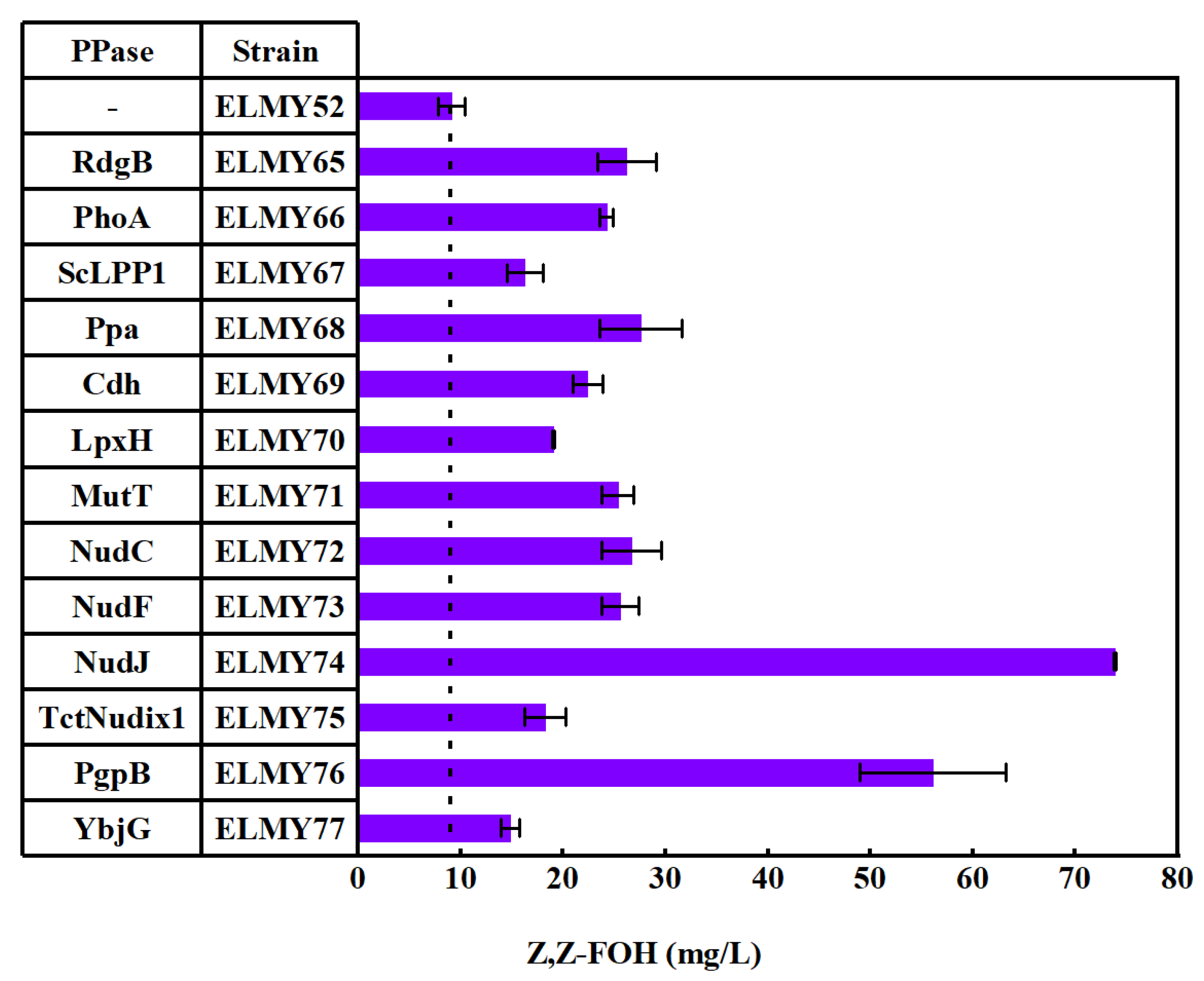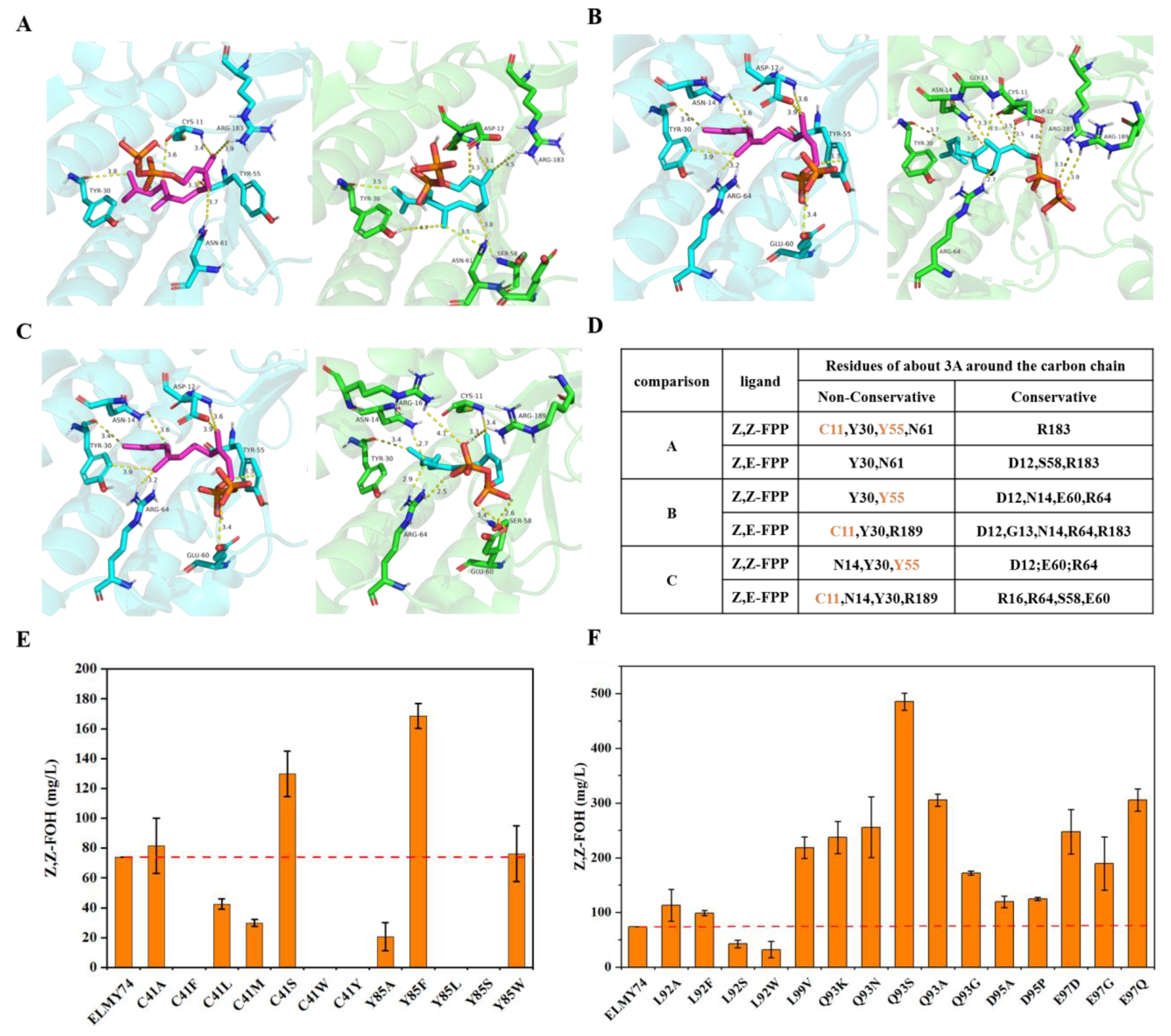Metabolic Engineering for Efficient Production of Z,Z-Farnesol in E. coli
Abstract
:1. Introduction
2. Materials and Methods
2.1. Strains, Plasmids, and Reagents
2.2. Construction of Plasmids and Strains
2.3. Model Analysis of Mvan4662-Z,Z-FPP Complex by Computational Simulation
2.4. Media and Cultivation Conditions
2.5. Biomass and Metabolite Analysis
3. Results
3.1. Screening Z-FPP Synthases with NPP as the Substrate
3.2. Effects of Phosphatases on Z,Z-FOH Production
3.3. Enhancing Z,Z-FPP Production through Engineering of Mvan4662
3.4. Batch Fermentation for Z,Z-FOH Production in E. coli
4. Discussion
Supplementary Materials
Author Contributions
Funding
Data Availability Statement
Conflicts of Interest
References
- Wang, C.; Zada, B.; Wei, G.; Kim, S.W. Metabolic engineering and synthetic biology approaches driving isoprenoid production in Escherichia coli. Bioresour. Technol. 2017, 241, 430–438. [Google Scholar] [CrossRef]
- Cheng, S.; Liu, X.; Jiang, G.; Wu, J.; Zhang, J.L.; Lei, D.; Yuan, Y.J.; Qiao, J.; Zhao, G.R. Orthogonal Engineering of Biosynthetic Pathway for Efficient Production of Limonene in Saccharomyces cerevisiae. ACS Synth. Biol. 2019, 8, 968–975. [Google Scholar] [CrossRef]
- Rehman, R.; Hanif, M.A.; Mushtaq, Z.; Al-Sadi, A.M. Biosynthesis of essential oils in aromatic plants: A review. Food Rev. Int. 2015, 32, 117–160. [Google Scholar] [CrossRef]
- Dudareva, N.; Klempien, A.; Muhlemann, J.K.; Kaplan, I. Biosynthesis, function and metabolic engineering of plant volatile organic compounds. New Phytol. 2013, 198, 16–32. [Google Scholar] [CrossRef] [PubMed]
- Yu, J.S.; Kleckley, T.S.; Wiemer, D.F. Synthesis of Farnesol Isomers via a Modified Wittig Procedure. Org. Lett. 2005, 7, 4803–4806. [Google Scholar] [CrossRef]
- Mo, X.; Cai, X.; Hui, Q.; Sun, H.; Yu, R.; Bu, R.; Yan, B.; Ou, Q.; Li, Q.; He, S.; et al. Whole genome sequencing and metabolomics analyses reveal the biosynthesis of nerol in a multi-stress-tolerant Meyerozyma guilliermondii GXDK6. Microb. Cell Fact. 2021, 20, 4. [Google Scholar] [CrossRef]
- Zhang, Y.; Nielsen, J.; Liu, Z. Engineering yeast metabolism for production of terpenoids for use as perfume ingredients, pharmaceuticals and biofuels. FEMS Yeast Res. 2017, 17, fox080. [Google Scholar] [CrossRef] [PubMed] [Green Version]
- Wu, J.; Cheng, S.; Cao, J.; Qiao, J.; Zhao, G.R. Systematic Optimization of Limonene Production in Engineered Escherichia coli. J. Agric. Food Chem. 2019, 67, 7087–7097. [Google Scholar] [CrossRef]
- You, S.; Chang, H.; Zhang, C.; Gao, L.; Qi, W.; Tao, Z.; Su, R.; He, Z. Recycling Strategy and Repression Elimination for Lignocellulosic-Based Farnesene Production with an Engineered E. coli. J. Agric. Food Chem. 2019, 67, 9858–9867. [Google Scholar] [CrossRef] [PubMed]
- Shukal, S.; Chen, X.; Zhang, C. Systematic engineering for high-yield production of viridiflorol and amorphadiene in auxotrophic E. coli. Metab. Eng. 2019, 55, 170–178. [Google Scholar] [CrossRef]
- Liao, P.; Hemmerlin, A.; Bach, T.J.; Chye, M.L. The potential of the mevalonate pathway for enhanced isoprenoid production. Biotechnol. Adv. 2016, 34, 697–713. [Google Scholar] [CrossRef]
- Hemmerlin, A.; Harwood, J.L.; Bach, T.J. A raison d‘etre for two distinct pathways in the early steps of plant isoprenoid biosynthesis? Prog. Lipid Res. 2012, 51, 95–148. [Google Scholar] [CrossRef]
- Li, M.; Hou, F.; Wu, T.; Jiang, X.; Li, F.; Liu, H.; Xian, M.; Zhang, H. Recent advances of metabolic engineering strategies in natural isoprenoid production using cell factories. Nat. Prod. Rep. 2020, 37, 80–99. [Google Scholar] [CrossRef] [PubMed]
- Wang, C.; Zhou, J.; Jang, H.J.; Yoon, S.H.; Kim, J.Y.; Lee, S.G.; Choi, E.S.; Kim, S.W. Engineered heterologous FPP synthases-mediated Z,E-FPP synthesis in E. coli. Metab. Eng. 2013, 18, 53–59. [Google Scholar] [CrossRef] [PubMed]
- Jiang, G.-Z.; Yao, M.-D.; Wang, Y.; Zhou, L.; Song, T.-Q.; Liu, H.; Xiao, W.-H.; Yuan, Y.-J. Manipulation of GES and ERG20 for geraniol overproduction in Saccharomyces cerevisiae. Metab. Eng. 2017, 41, 57–66. [Google Scholar] [CrossRef]
- Nagel, R.; Schmidt, A.; Peters, R.J. Isoprenyl diphosphate synthases: The chain length determining step in terpene biosynthesis. Planta 2019, 249, 9–20. [Google Scholar] [CrossRef] [PubMed]
- Coates, R.M.; Denissen, J.F.; Juvik, J.A.; Babka, B.A. Identification of alpha.-santalenoic and endo-.beta.-bergamotenoic acids as moth oviposition stimulants from wild tomato leaves. J. Org. Chem. 2002, 53, 2186–2192. [Google Scholar] [CrossRef]
- Akhtar, T.A.; Matsuba, Y.; Schauvinhold, I.; Yu, G.; Lees, H.A.; Klein, S.E.; Pichersky, E. The tomato cis-prenyltransferase gene family. Plant J. 2013, 73, 640–652. [Google Scholar] [CrossRef]
- Nagaki, M.; Ichijo, T.; Kobashi, R.; Yagihashi, Y.; Musashi, T.; Kawakami, J.; Ohya, N.; Gotoh, T.; Sagami, H. Substrate specificities of E- and Z-farnesyl diphosphate synthases with substrate analogs. J. Mol. Catal. B Enzym. 2012, 80, 1–6. [Google Scholar] [CrossRef]
- Men, X.; Wang, F.; Chen, G.Q.; Zhang, H.B.; Xian, M. Biosynthesis of Natural Rubber: Current State and Perspectives. Int. J. Mol. Sci. 2018, 20, 50. [Google Scholar] [CrossRef] [Green Version]
- Beran, F.; Rahfeld, P.; Luck, K.; Nagel, R.; Vogel, H.; Wielsch, N.; Irmisch, S.; Ramasamy, S.; Gershenzon, J.; Heckel, D.G.; et al. Novel family of terpene synthases evolved from trans-isoprenyl diphosphate synthases in a flea beetle. Proc. Natl. Acad. Sci. USA 2016, 113, 2922–2927. [Google Scholar] [CrossRef] [Green Version]
- Sallaud, C.; Rontein, D.; Onillon, S.; Jabes, F.; Duffe, P.; Giacalone, C.; Thoraval, S.; Escoffier, C.; Herbette, G.; Leonhardt, N.; et al. A novel pathway for sesquiterpene biosynthesis from Z,Z-farnesyl pyrophosphate in the wild tomato Solanum habrochaites. Plant Cell 2009, 21, 301–317. [Google Scholar] [CrossRef] [Green Version]
- Schulbach, M.C.; Brennan, P.J.; Crick, D.C. Identification of a Short (C15) ChainZ-Isoprenyl Diphosphate Synthase and a Homologous Long (C50) Chain Isoprenyl Diphosphate Synthase in Mycobacterium tuberculosis. J. Biol. Chem. 2000, 275, 22876–22881. [Google Scholar] [CrossRef] [Green Version]
- Sato, T.; Takizawa, K.; Orito, Y.; Kudo, H.; Hoshino, T. Insight into C35 terpene biosyntheses by nonpathogenic Mycobacterium Species: Functional analyses of three Z-prenyltransferases and identification of dehydroheptaprenylcyclines. Chembiochem 2010, 11, 1874–1881. [Google Scholar] [CrossRef] [PubMed]
- Schilmiller, A.L.; Schauvinhold, I.; Larson, M.; Xu, R.; Charbonneau, A.L.; Schmidt, A.; Wilkerson, C.; Last, R.L.; Pichersky, E. Monoterpenes in the glandular trichomes of tomato are synthesized from a neryl diphosphate precursor rather than geranyl diphosphate. Proc. Natl. Acad. Sci. USA 2009, 106, 10865–10870. [Google Scholar] [CrossRef] [Green Version]
- Lei, D.; Qiu, Z.; Wu, J.; Qiao, B.; Qiao, J.; Zhao, G.R. Combining Metabolic and Monoterpene Synthase Engineering for De Novo Production of Monoterpene Alcohols in E. coli. ACS Synth. Biol. 2021, 10, 1531–1544. [Google Scholar] [CrossRef]
- Gutensohn, M.; Nguyen, T.T.; McMahon, R.D., 3rd; Kaplan, I.; Pichersky, E.; Dudareva, N. Metabolic engineering of monoterpene biosynthesis in tomato fruits via introduction of the non-canonical substrate neryl diphosphate. Metab. Eng. 2014, 24, 107–116. [Google Scholar] [CrossRef] [PubMed]
- Wang, C.; Park, J.E.; Choi, E.S.; Kim, S.W. Farnesol production in Escherichia coli through the construction of a farnesol biosynthesis pathway—application of PgpB and YbjG phosphatases. Biotechnol. J. 2016, 11, 1291–1297. [Google Scholar] [CrossRef] [PubMed]
- Wang, C.; Yoon, S.H.; Shah, A.A.; Chung, Y.R.; Kim, J.Y.; Choi, E.S.; Keasling, J.D.; Kim, S.W. Farnesol production from E. coli by harnessing the exogenous mevalonate pathway. Biotechnol. Bioeng. 2010, 107, 421–429. [Google Scholar] [CrossRef]
- Wang, C.; Kim, J.-Y.; Choi, E.-S.; Kim, S.-W. Microbial production of farnesol (FOH): Current states and beyond. Process Biochem. 2011, 46, 1221–1229. [Google Scholar] [CrossRef]
- Chang, H.Y.; Cheng, T.H.; Wang, A.H. Structure, catalysis, and inhibition mechanism of prenyltransferase. IUBMB Life 2021, 73, 40–63. [Google Scholar] [CrossRef]
- Chen, C.-C.; Zhang, L.; Yu, X.; Ma, L.; Ko, T.-P.; Guo, R.-T. Versatile cis-isoprenyl Diphosphate Synthase Superfamily Members in Catalyzing Carbon–Carbon Bond Formation. ACS Catal. 2020, 10, 4717–4725. [Google Scholar] [CrossRef]
- Takahashi, S.; Koyama, T. Structure and function of cis-prenyl chain elongating enzymes. Chem. Rec. 2006, 6, 194–205. [Google Scholar] [CrossRef]
- De Araújo Delmondes, G.; Bezerra, D.S.; de Queiroz Dias, D.; de Souza Borges, A.; Araújo, I.M.; Lins da Cunha, G.; Bandeira, P.F.R.; Barbosa, R.; Melo Coutinho, H.D.; Felipe, C.F.B.; et al. Toxicological and pharmacologic effects of farnesol (C15H26O): A descriptive systematic review. Food Chem. Toxicol. 2019, 129, 169–200. [Google Scholar] [CrossRef]
- George, K.W.; Thompson, M.G.; Kang, A.; Baidoo, E.; Wang, G.; Chan, L.J.; Adams, P.D.; Petzold, C.J.; Keasling, J.D.; Lee, T.S. Metabolic engineering for the high-yield production of isoprenoid-based C₅ alcohols in E. coli. Sci. Rep. 2015, 5, 11128. [Google Scholar] [CrossRef] [PubMed] [Green Version]
- Kang, A.; George, K.W.; Wang, G.; Baidoo, E.; Keasling, J.D.; Lee, T.S. Isopentenyl diphosphate (IPP)-bypass mevalonate pathways for isopentenol production. Metab. Eng. 2016, 34, 25–35. [Google Scholar] [CrossRef] [PubMed] [Green Version]
- Zada, B.; Wang, C.; Park, J.B.; Jeong, S.H.; Park, J.E.; Singh, H.B.; Kim, S.W. Metabolic engineering of Escherichia coli for production of mixed isoprenoid alcohols and their derivatives. Biotechnol. Biofuels 2018, 11, 210. [Google Scholar] [CrossRef] [PubMed] [Green Version]





| Strains | Description | Source |
|---|---|---|
| BW25113(DE3) | E. coli BW25113 with T7 RNA polymerase gene in the chromosome | [26] |
| EIP81 | BW25113(DE3) harboring plasmids pMAP6 and pISP5 | [26] |
| ELMY28 | EIP81 harboring plasmid pLMY28 | This study |
| ELMY51 | ELMY28 harboring plasmid pLMY51 | This study |
| ELMY52 | ELMY28 harboring plasmid pLMY52 | This study |
| ELMY53 | ELMY28 harboring plasmid pLMY53 | This study |
| ELMY57 | ELMY28 harboring plasmid pLMY57 | This study |
| ELMY61 | ELMY28 harboring plasmid pLMY61 | This study |
| ELMY63 | ELMY28 harboring plasmid pLMY63 | This study |
| ELMY65 | ELMY28 harboring plasmid pLMY65 | This study |
| ELMY66 | ELMY28 harboring plasmid pLMY66 | This study |
| ELMY67 | ELMY28 harboring plasmid pLMY67 | This study |
| ELMY68 | ELMY28 harboring plasmid pLMY68 | This study |
| ELMY69 | ELMY28 harboring plasmid pLMY69 | This study |
| ELMY70 | ELMY28 harboring plasmid pLMY70 | This study |
| ELMY71 | ELMY28 harboring plasmid pLMY71 | This study |
| ELMY72 | ELMY28 harboring plasmid pLMY72 | This study |
| ELMY73 | ELMY28 harboring plasmid pLMY73 | This study |
| ELMY74 | ELMY28 harboring plasmid pLMY74 | This study |
| ELMY75 | ELMY28 harboring plasmid pLMY75 | This study |
| ELMY81 | ELMY28 harboring plasmid pLMY81 | This study |
| ELMY82 | ELMY28 harboring plasmid pLMY82 | This study |
| ELMY83 | ELMY28 harboring plasmid pLMY83 | This study |
| ELMY84 | ELMY28 harboring plasmid pLMY84 | This study |
| ELMY85 | ELMY28 harboring plasmid pLMY85 | This study |
| ELMY86 | ELMY28 harboring plasmid pLMY86 | This study |
| ELMY87 | ELMY28 harboring plasmid pLMY87 | This study |
| ELMY88 | ELMY28 harboring plasmid pLMY88 | This study |
| ELMY89 | ELMY28 harboring plasmid pLMY89 | This study |
| ELMY90 | ELMY28 harboring plasmid pLMY90 | This study |
| ELMY91 | ELMY28 harboring plasmid pLMY91 | This study |
| ELMY92 | ELMY28 harboring plasmid pLMY92 | This study |
| ELMY93 | ELMY28 harboring plasmid pLMY93 | This study |
| ELMY94 | ELMY28 harboring plasmid pLMY94 | This study |
| ELMY95 | ELMY28 harboring plasmid pLMY95 | This study |
| ELMY96 | ELMY28 harboring plasmid pLMY96 | This study |
| ELMY97 | ELMY28 harboring plasmid pLMY97 | This study |
| ELMY98 | ELMY28 harboring plasmid pLMY98 | This study |
| ELMY99 | ELMY28 harboring plasmid pLMY99 | This study |
| ELMY100 | ELMY28 harboring plasmid pLMY100 | This study |
| ELMY101 | ELMY28 harboring plasmid pLMY101 | This study |
| ELMY106 | ELMY28 harboring plasmid pLMY106 | This study |
| ELMY107 | ELMY28 harboring plasmid pLMY107 | This study |
| ELMY108 | ELMY28 harboring plasmid pLMY108 | This study |
| ELMY109 | ELMY28 harboring plasmid pLMY109 | This study |
| ELMY110 | ELMY28 harboring plasmid pLMY110 | This study |
| ELMY112 | ELMY28 harboring plasmid pLMY112 | This study |
| ELMY113 | ELMY28 harboring plasmid pLMY113 | This study |
| Plasmid | Description | Source |
|---|---|---|
| pMAP6 | pETDuet-1, PT7-EfmvaE-PT7-EfmvaSA110G, AmpR | [8] |
| pISP5 | pCDFDuet-1, PT7-MmMK-ScPMK-ScPMD-ScIDI, StrR | [8] |
| pLMY28 | pACYCDuet-1, PT7-SltNPPS, ChlR | This study |
| pLMY51 | pRSFDuet-1, PT7-PstIDS3, KanR | This study |
| pLMY52 | pRSFDuet-1, PT7-mvan4662, KanR | This study |
| pLMY53 | pRSFDuet-1, PT7-rv1086, KanR | This study |
| pLMY57 | pRSFDuet-1, PT7-IspA-rv1086, KanR | This study |
| pLMY61 | pRSFDuet-1, PT7-SltCPT6, KanR | This study |
| pLMY63 | pRSFDuet-1, PT7-ShtZFPS, KanR | This study |
| pLMY65 | pRSFDuet-1, PT7-mvan4662-PT7-rdgB, KanR | This study |
| pLMY66 | pRSFDuet-1, PT7-mvan4662-PT7-phoA, KanR | This study |
| pLMY67 | pRSFDuet-1, PT7-mvan4662-PT7-ScLpp1, KanR | This study |
| pLMY68 | pRSFDuet-1, PT7-mvan4662-PT7-ppa, KanR | This study |
| pLMY69 | pRSFDuet-1, PT7-mvan4662-PT7-cdh, KanR | This study |
| pLMY70 | pRSFDuet-1, PT7-mvan4662-PT7-lpxH, KanR | This study |
| pLMY71 | pRSFDuet-1, PT7-mvan4662-PT7-mutT, KanR | This study |
| pLMY72 | pRSFDuet-1, PT7-mvan4662-PT7-nudC, KanR | This study |
| pLMY73 | pRSFDuet-1, PT7-mvan4662-PT7-nudF, KanR | This study |
| pLMY74 | pRSFDuet-1, PT7-mvan4662-PT7-nudJ, KanR | This study |
| pLMY75 | pRSFDuet-1, PT7-mvan4662-PT7-TctNudix1, KanR | This study |
| pLMY76 | pRSFDuet-1, PT7-mvan4662-PT7-pgpB, KanR | This study |
| pLMY77 | pRSFDuet-1, PT7-mvan4662-PT7-ybjG, KanR | This study |
| pLMY81 | pRSFDuet-1, PT7-mvan4662C41A-PT7-nudJ, KanR | This study |
| pLMY82 | pRSFDuet-1, PT7-mvan4662C41F-PT7-nudJ, KanR | This study |
| pLMY83 | pRSFDuet-1, PT7-mvan4662C41L-PT7-nudJ, KanR | This study |
| pLMY84 | pRSFDuet-1, PT7-mvan4662C41M-PT7-nudJ, KanR | This study |
| pLMY85 | pRSFDuet-1, PT7-mvan4662C41S-PT7-nudJ, KanR | This study |
| pLMY86 | pRSFDuet-1, PT7-mvan4662C41W-PT7-nudJ, KanR | This study |
| pLMY87 | pRSFDuet-1, PT7-mvan4662C41Y-PT7-nudJ, KanR | This study |
| pLMY88 | pRSFDuet-1, PT7-mvan4662D95A-PT7-nudJ, KanR | This study |
| pLMY89 | pRSFDuet-1, PT7-mvan4662D95P-PT7-nudJ, KanR | This study |
| pLMY90 | pRSFDuet-1, PT7-mvan4662D95S-PT7-nudJ, KanR | This study |
| pLMY91 | pRSFDuet-1, PT7-mvan4662E97D-PT7-nudJ, KanR | This study |
| pLMY92 | pRSFDuet-1, PT7-mvan4662E97G-PT7-nudJ, KanR | This study |
| pLMY93 | pRSFDuet-1, PT7-mvan4662E97Q-PT7-nudJ, KanR | This study |
| pLMY94 | pRSFDuet-1, PT7-mvan4662L92A-PT7-nudJ, KanR | This study |
| pLMY95 | pRSFDuet-1, PT7-mvan4662L92F-PT7-nudJ, KanR | This study |
| pLMY96 | pRSFDuet-1, PT7-mvan4662L92S-PT7-nudJ, KanR | This study |
| pLMY97 | pRSFDuet-1, PT7-mvan4662L92W-PT7-nudJ, KanR | This study |
| pLMY98 | pRSFDuet-1, PT7-mvan4662L99V-PT7-nudJ, KanR | This study |
| pLMY99 | pRSFDuet-1, PT7-mvan4662Q93K-PT7-nudJ, KanR | This study |
| pLMY100 | pRSFDuet-1, PT7-mvan4662Q93N-PT7-nudJ, KanR | This study |
| pLMY101 | pRSFDuet-1, PT7-mvan4662Q93S-PT7-nudJ, KanR | This study |
| pLMY106 | pRSFDuet-1, PT7-mvan4662Y85A-PT7-nudJ, KanR | This study |
| pLMY107 | pRSFDuet-1, PT7-mvan4662Y85F-PT7-nudJ, KanR | This study |
| pLMY108 | pRSFDuet-1, PT7-mvan4662Y85L-PT7-nudJ, KanR | This study |
| pLMY109 | pRSFDuet-1, PT7-mvan4662Y85S-PT7-nudJ, KanR | This study |
| pLMY110 | pRSFDuet-1, PT7-mvan4662Y85W-PT7-nudJ, KanR | This study |
| pLMY112 | pRSFDuet-1, PT7-mvan4662Q93A-PT7-nudJ, KanR | This study |
| pLMY113 | pRSFDuet-1, PT7-mvan4662Q93G-PT7-nudJ, KanR | This study |
Disclaimer/Publisher’s Note: The statements, opinions and data contained in all publications are solely those of the individual author(s) and contributor(s) and not of MDPI and/or the editor(s). MDPI and/or the editor(s) disclaim responsibility for any injury to people or property resulting from any ideas, methods, instructions or products referred to in the content. |
© 2023 by the authors. Licensee MDPI, Basel, Switzerland. This article is an open access article distributed under the terms and conditions of the Creative Commons Attribution (CC BY) license (https://creativecommons.org/licenses/by/4.0/).
Share and Cite
Lei, M.; Qiu, Z.; Guan, L.; Xiang, Z.; Zhao, G.-R. Metabolic Engineering for Efficient Production of Z,Z-Farnesol in E. coli. Microorganisms 2023, 11, 1583. https://doi.org/10.3390/microorganisms11061583
Lei M, Qiu Z, Guan L, Xiang Z, Zhao G-R. Metabolic Engineering for Efficient Production of Z,Z-Farnesol in E. coli. Microorganisms. 2023; 11(6):1583. https://doi.org/10.3390/microorganisms11061583
Chicago/Turabian StyleLei, Mengyang, Zetian Qiu, Leilei Guan, Zheng Xiang, and Guang-Rong Zhao. 2023. "Metabolic Engineering for Efficient Production of Z,Z-Farnesol in E. coli" Microorganisms 11, no. 6: 1583. https://doi.org/10.3390/microorganisms11061583





